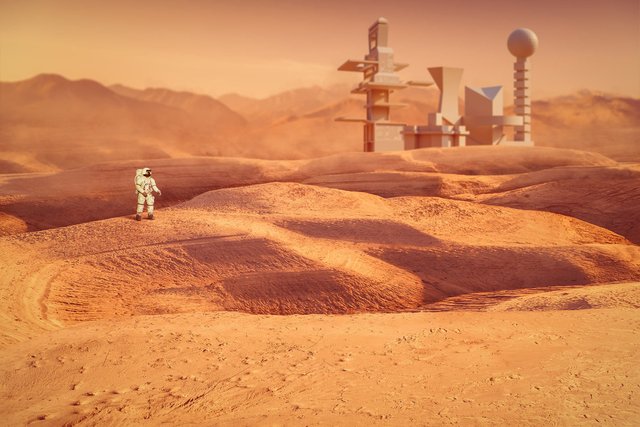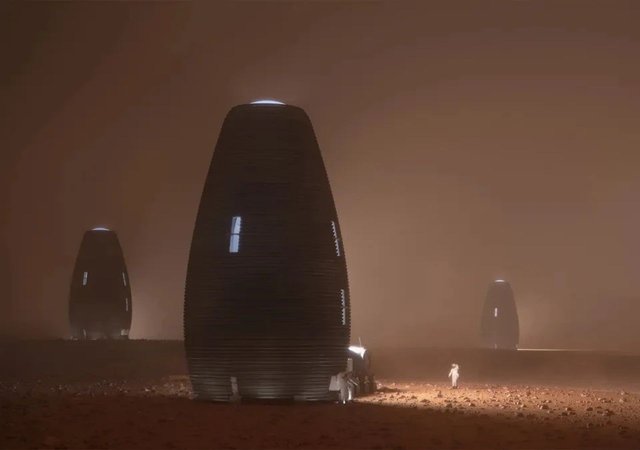
Source
Once we've overcome all the enormous challenges of getting a craft like Starship to Mars, then transporting a crew and keeping them safe for six months, we need to have a minimal infrastructure in place before the first humans set foot on the planet. This is especially difficult in an environment where there's virtually nothing but dust and rocks, which would initially require us to bring both materials and machinery to the red planet to create the overall infrastructure.
Una vez que hayamos superado todos los enormes problemas que conlleva llevar a Marte una nave como Starship y luego llevar tripulación y mantenerla a salvo durante seis meses de viaje, tenemos que tener una infraestructura mínima antes de que los primeros humanos pisen el planeta. Esto resulta especialmente difícil en un entorno donde no hay prácticamente nada más que polvo y rocas, lo que a priori nos obligaría a llevar tanto materiales como maquinaria al planeta rojo para poder crear las infraestructuras generales.
Typically, ideas proposed in this regard tend to involve underground installations or inflatable modules, but now a group of scientists has developed self-growing bricks, biotechnological building materials designed to manufacture and repair themselves using local Martian resources, such as regolith (Martian soil), and engineered living organisms, such as bacteria, fungi, and cyanobacteria. These organisms work together to produce biominerals and biopolymers that bind soil particles into solid blocks.
Normalmente las ideas que se plantean en este sentido suelen ser instalaciones subterráneas o módulos inflables, pero ahora un grupo de científicos han desarrollado ladrillos que crecen solos, materiales de construcción biotecnológicos diseñados para fabricarse y repararse por sí mismos utilizando recursos locales de Marte, como el regolito (suelo marciano), y organismos vivos modificados, como bacterias, hongos y cianobacterias. Estos organismos trabajan juntos para producir biominerales y biopolímeros que unen las partículas del suelo en bloques sólidos.

Source
Once mixing begins in a bioreactor, the microorganisms "grow" and consolidate the material, forming bricks without direct human intervention. The process can harness sunlight and carbon dioxide from the Martian atmosphere, making the system self-sustaining. If the bricks become cracked or damaged, the living organisms inside can activate biomineralization processes to repair the cracks, similar to how some self-healing materials function on Earth.
Una vez iniciada la mezcla en un biorreactor, los microorganismos “crecen” y consolidan el material, formando ladrillos sin intervención humana directa. El proceso puede aprovechar la luz solar y el dióxido de carbono de la atmósfera marciana, haciendo el sistema autosostenible Si los ladrillos sufren grietas o daños, los organismos vivos en su interior pueden activar procesos de biomineralización para reparar las fisuras, similar a cómo algunos materiales autorreparables funcionan en la Tierra.
The process works as follows: the regolith that forms the Martian soil is mixed with water and minimal nutrients, and cyanobacteria and filamentous fungi engineered to survive under controlled conditions within a bioreactor are added. The microorganisms produce calcium carbonate and biopolymers, which cement the regolith particles together into solid blocks. Finally, the bricks are extracted from the bioreactor and assembled to build walls, floors, and other habitable structures.
El proceso funciona de la siguiente manera: el regolito que forma el suelo marciano se mezcla con agua y nutrientes mínimos, se añaden las cianobacterias y hongos filamentosos diseñados para sobrevivir en condiciones controladas dentro de un biorreactor. Los microorganismos producen carbonato de calcio y biopolímeros, que cementan las partículas del regolito formando bloques sólidos. Finalmente los ladrillos se extraen del biorreactor y se ensamblan para construir paredes, pisos y otras estructuras habitables.

Source
The main advantage of this project is that, to build the infrastructure, only the microorganisms and small reactors need to be transported; the rest of the materials can be obtained from the Martian soil, significantly reducing launch and transportation costs. The bricks can be grown in custom shapes and sizes using molds and 3D printing techniques. Furthermore, the entire system can be self-sufficient and contribute to carbon dioxide capture for other uses.
La principal ventaja de este proyecto es que, para construir las infrastructuras, solo se necesita llevar los microorganismos y pequeños reactores, el resto de los materiales se pueden obtener del suelo de Marte lo que reduce considerablemente los costes de lanzamiento y transporte. Los ladrillos pueden crecer en formas y tamaños personalizados usando moldes y técnicas de impresión 3D. Además todo el sistema puede ser autosuficiente y contribuir a la captura de dióxido de carbono para otros usos.
Althought these bricks represent a biotechnological revolution for construction on Mars or the Moon (which would also work with lunar regolith), allowing future homes to literally "grow" using life and resources in situ, some challenges remain. Microorganisms cannot survive directly on the Martian surface, so the process requires bioreactors protected from extreme cold and radiation. Although promising, the process is still in the experimental phase and requires further research for large-scale applications on Mars.
Si bien estos ladrillos representan una revolución biotecnológica para la construcción en Marte o la Luna (que también funcionaría con regolito lunar), permitiendo que las futuras casas literalmente “crezcan” usando vida y recursos in situ, añun quedan algunos desafíos por resolver. Los microorganismos no sobreviven directamente en la superficie marciana, por lo que el proceso requiere biorreactores protegidos del frío extremo y la radiación. Aunque prometedor, el proceso aún está en fase experimental y requiere más investigación para aplicaciones a gran escala en Marte.
More information/Más información
https://scitechdaily.com/scientists-create-living-bricks-to-build-homes-on-mars/
Construir en Marte es un desafíos inalcanzable si ni siquiera se ha logrado hacer un viaje tripulado. Es que creo que enviaremos robots con IA para el viaje y la construcción tal vez precaria en el planeta rojo. Eso serán solo ficción por el resto de la vida que me queda y tal vez la de mis nietos que aún no tengo.
Saludos y bendiciones.
Downvoting a post can decrease pending rewards and make it less visible. Common reasons:
Submit